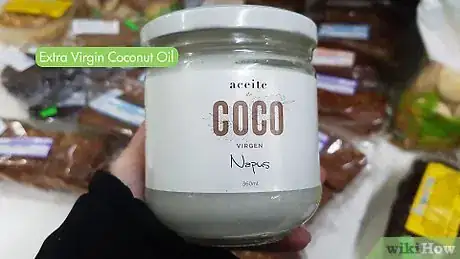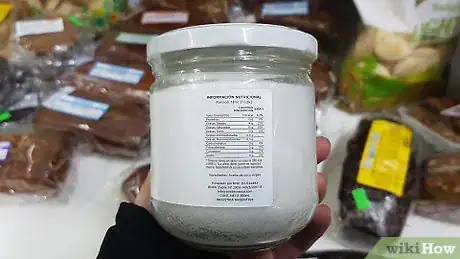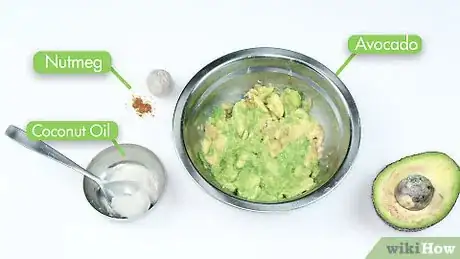This article was co-authored by Joanna Kula. Joanna Kula is a Licensed Esthetician, Owner and Founder of Skin Devotee Facial Studio in Philadelphia. With over 10 years of experience in skincare, Joanna specializes in transformative facial treatments to help clients achieve a lifetime of healthy, beautiful, and radiant skin. She is also a contributing author for the prestigious Les Nouvelles Esthetiques & Spa magazine and has been featured in a number of magazines including InStyle.
This article has been viewed 40,071 times.
Coconut oil has known antibacterial and antifungal properties, making it good for cooking and for your skin. It is gentler than chemical-laden face products and is hydrating for most skin types. That said, coconut oil can clog pores. People with oily or acne-prone skin should use it sparingly.[1] To integrate coconut oil into your skin care routine, start by selecting coconut oil that is organic and safe for your skin. Then, apply the coconut oil with clean fingers to soothe dry, irritated skin. You can also use coconut oil in face masks to add more moisture to your skin.
Steps
Selecting the Coconut Oil
-
1Consider your skin type before using coconut oil. While coconut oil can be a great moisturizer for some people, it may not be the best choice for others. Coconut oil may be suitable for dry or normal skin types. If you have oily or acne prone skin, use coconut oil sparingly or choose another natural treatment, such as tea tree oil or aloe vera gel.[2]
- Applying coconut oil to skin that is already oily may worsen the problem, as it is highly comedogenic and has the potential to clog pores.[3]
-
2Look for organic, extra virgin coconut oil. Getting coconut oil that is organic will ensure it contains no GMOs. Extra virgin coconut oil is more pure than virgin oil, so it does not have any preservatives or additives that could irritate your skin.[4]
- Shop for extra virgin coconut oil at your local health food store or online.
Advertisement -
3Make sure the oil is unrefined and unprocessed. Check the label on the coconut oil to ensure it has not been hydrogenated, bleached, refined, or deodorized. Getting it unrefined and unprocessed will ensure it is of the highest quality.[5]
- You may notice that the label says “cold-pressed.” This is a natural process for extracting the oil and it is not the same thing as processed or refined.
-
4Get coconut oil in solid form. Coconut oil is usually sold in glass bottles in a solid state. It may appear thick and white in the bottle.[6]
- Make sure you store the coconut oil in a cool, dark place in your home, preferably at 76 °F (24 °C), so it maintains a solid state. A bathroom drawer or cupboard is a good storage spot.
- It does not need to be refrigerated to stay fresh.
Applying the Coconut Oil
-
1Wash your face. Use your regular cleanser to remove any dirt, dead skin, and bacteria from your face.[7]
- Rinse off your cleanser with warm water, as warm water helps to open your pores.
-
2Dab 1 teaspoon (4.9 ml) of oil onto your face. Use clean fingers to scoop out a teaspoon of coconut oil from the bottle. Then, dab it onto your forehead, cheeks, nose, upper lip, and chin. Use circular motions to gently spread it on your skin.[8]
- The oil should melt and become more liquid as you spread it due to the heat of your fingers.
- If you are concerned you may be allergic to coconut oil, apply a small amount to your jaw line. Wait 24 hours. If your skin does not react badly in that time span, it is likely safe to use.
-
3Let the oil dry and absorb into your skin. It should take no more than one minute for it to dry. Once it has absorbed, you should not feel any greasy residue on your skin. Due to the properties of coconut oil, it will dry fast without residue.[9]
-
4Apply the oil once a day, or as needed. Integrate it into your normal skincare routine, applying it once a day after washing your face in the morning or at night.[10]
- If you notice dry patches on your skin, apply the coconut oil as a spot treatment to these areas.
- If you have very dry skin, you may apply it after washing your face once in the morning and again at night.
-
5Stop using coconut oil if you have breakouts. If you notice any pimples, bumps, or acne appears on your skin after you start using coconut oil, stop applying it.[11] Speak to your dermatologist for advice on moisturizers that will work with your skin type.
Using the Coconut Oil in Face Masks
-
1Make a face mask with honey and lemon. Combine 1 tablespoon (15 ml) of liquid coconut oil, 2 tablespoons (30 ml) of raw, unprocessed honey, and 1⁄2 tablespoon (7.4 ml) of lemon juice in a small bowl. Apply the mask to your face and let it sit for 10 minutes. Then, rinse it off with cool water and pat your face dry with a towel.[12]
- This mask is great for brightening up dull or dry skin.
-
2Try a moisturizing mask with banana and turmeric. Mash ½ a banana in a bowl. Then, add together 1 tablespoon (15 ml) of coconut oil and a pinch of turmeric. Stir to combine. Apply the mask to your face with clean fingers and let it sit for 15 minutes. Then, rinse it off with cool water and pat your face dry with a towel.[13]
- This is a great mask for moisturizing your skin and removing acne-causing bacteria.
- If you have oily skin or if you are prone to acne, use just a few drops of oil instead of an entire tablespoon.
-
3Prepare an avocado and nutmeg mask. Mash ¼ of an avocado in a bowl to form a smooth paste. Then, add 1 tablespoon (15 ml) of coconut oil and 1⁄2 tablespoon (7.4 ml) of nutmeg to the bowl. Put the mask on your face with clean fingers and allow it to sit for 15 minutes. Rinse if off with cool water or a warm washcloth. Dry your face with a clean towel.[14]
- Avocados are a great source of nutrients, healthy fats and antioxidants, so an avocado mask can help to soothe, soften and moisturize the skin.[15] This mask is particularly good for moisturizing your skin and preventing future breakouts if you have dry skin.
Expert Q&A
-
QuestionCan coconut oil be used as a cleanser?
 Joanna KulaJoanna Kula is a Licensed Esthetician, Owner and Founder of Skin Devotee Facial Studio in Philadelphia. With over 10 years of experience in skincare, Joanna specializes in transformative facial treatments to help clients achieve a lifetime of healthy, beautiful, and radiant skin. She is also a contributing author for the prestigious Les Nouvelles Esthetiques & Spa magazine and has been featured in a number of magazines including InStyle.
Joanna KulaJoanna Kula is a Licensed Esthetician, Owner and Founder of Skin Devotee Facial Studio in Philadelphia. With over 10 years of experience in skincare, Joanna specializes in transformative facial treatments to help clients achieve a lifetime of healthy, beautiful, and radiant skin. She is also a contributing author for the prestigious Les Nouvelles Esthetiques & Spa magazine and has been featured in a number of magazines including InStyle.
Licensed Esthetician I do not recommend coconut oil as a face cleanser. It can be difficult to remove and leaves behind a layer of residue. It’s highly comedogenic and can contribute to acne and breakouts.
I do not recommend coconut oil as a face cleanser. It can be difficult to remove and leaves behind a layer of residue. It’s highly comedogenic and can contribute to acne and breakouts. -
QuestionCan I use coconut oil as a moisturizer before applying makeup?
 Laura MartinLaura Martin is a Licensed Cosmetologist in Georgia. She has been a hair stylist since 2007 and a cosmetology teacher since 2013.
Laura MartinLaura Martin is a Licensed Cosmetologist in Georgia. She has been a hair stylist since 2007 and a cosmetology teacher since 2013.
Licensed Cosmetologist Coconut oil doesn't fully absorb into the skin. This makes it great as a treatment product, but not great for daily wear. I would not recommend using it before applying makeup.
Coconut oil doesn't fully absorb into the skin. This makes it great as a treatment product, but not great for daily wear. I would not recommend using it before applying makeup. -
QuestionCan I use coconut oil on my face as a moisturizer?
 Laura MartinLaura Martin is a Licensed Cosmetologist in Georgia. She has been a hair stylist since 2007 and a cosmetology teacher since 2013.
Laura MartinLaura Martin is a Licensed Cosmetologist in Georgia. She has been a hair stylist since 2007 and a cosmetology teacher since 2013.
Licensed Cosmetologist Yes, but it needs to be raw, virgin coconut oil. Some people have a reaction to coconut oil, so try it out in a small area before applying all over.
Yes, but it needs to be raw, virgin coconut oil. Some people have a reaction to coconut oil, so try it out in a small area before applying all over.
References
- ↑ Joanna Kula. Skincare Specialist. Expert Interview.9 July 2019.
- ↑ http://www.cosmopolitan.com/uk/beauty-hair/news/a36363/best-oils-to-fight-oily-skin-and-breakouts-yes-really/
- ↑ Joanna Kula. Skincare Specialist. Expert Interview.9 July 2019.
- ↑ http://blog.paleohacks.com/coconut-oil-for-skin/
- ↑ http://blog.paleohacks.com/coconut-oil-for-skin/
- ↑ https://bellatory.com/skin/coconut-oil-acne
- ↑ http://blog.paleohacks.com/coconut-oil-for-skin/
- ↑ https://bellatory.com/skin/coconut-oil-acne
- ↑ https://bellatory.com/skin/coconut-oil-acne
- ↑ https://bellatory.com/skin/coconut-oil-acne
- ↑ Joanna Kula. Skincare Specialist. Expert Interview.9 July 2019.
- ↑ https://bellatory.com/skin/Coconut-Oil-Face-Mask-Recipes
- ↑ https://bellatory.com/skin/Coconut-Oil-Face-Mask-Recipes
- ↑ https://bellatory.com/skin/Coconut-Oil-Face-Mask-Recipes
- ↑ Joanna Kula. Skincare Specialist. Expert Interview.9 July 2019.
































































